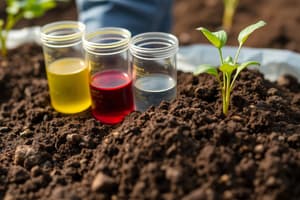Podcast
Questions and Answers
What does soil pH measure?
What does soil pH measure?
- The acidity or alkalinity of the soil. (correct)
- The salt content of the soil.
- The moisture content of the soil.
- The density of the soil.
On the pH scale, what value is considered neutral?
On the pH scale, what value is considered neutral?
- 0
- 14
- 7 (correct)
- 1
What is soil salinity?
What is soil salinity?
- The acidity level of the soil.
- The alkalinity level of the soil.
- The organic matter content of the soil.
- The salt content of the soil. (correct)
In the laboratory procedure for determining actual soil pH (pH H2O), what is mixed with the soil?
In the laboratory procedure for determining actual soil pH (pH H2O), what is mixed with the soil?
What type of container is used in the lab to determine the actual pH?
What type of container is used in the lab to determine the actual pH?
What chemical solution is used to determine potential pH?
What chemical solution is used to determine potential pH?
When determining 'potential pH', how long should the soil and solution be shaken?
When determining 'potential pH', how long should the soil and solution be shaken?
In the lab procedure for determining soil salinity, what is mixed with the soil?
In the lab procedure for determining soil salinity, what is mixed with the soil?
What piece of lab equipment is used to analyze the sample for salinity?
What piece of lab equipment is used to analyze the sample for salinity?
According to the lab rules, what should be done to centrifuges before starting them?
According to the lab rules, what should be done to centrifuges before starting them?
If using a centrifuge with an odd number of samples, how is it balanced?
If using a centrifuge with an odd number of samples, how is it balanced?
What term is used to describe the remaining solution above the pellet after centrifugation?
What term is used to describe the remaining solution above the pellet after centrifugation?
What is the sorption complex?
What is the sorption complex?
Which of the following describes 'adsorption'?
Which of the following describes 'adsorption'?
What process involves the accumulation of molecules within existing solids?
What process involves the accumulation of molecules within existing solids?
What balance is a key determinant of soil acidity or alkalinity?
What balance is a key determinant of soil acidity or alkalinity?
What dictates the balance between H+ and OH- ions in the soil solution?
What dictates the balance between H+ and OH- ions in the soil solution?
Which of the following pH values indicates an acidic soil?
Which of the following pH values indicates an acidic soil?
Which of the following pH values indicates an alkaline soil?
Which of the following pH values indicates an alkaline soil?
What is a neutral pH value?
What is a neutral pH value?
Which of the following factors contributes to natural soil pH variability?
Which of the following factors contributes to natural soil pH variability?
How does soil pH affect nutrients in the soil?
How does soil pH affect nutrients in the soil?
When are most mineral nutrients readily available to plants in terms of soil pH?
When are most mineral nutrients readily available to plants in terms of soil pH?
What characterizes strongly acidic soils, regarding plant growth?
What characterizes strongly acidic soils, regarding plant growth?
What could cause a soil to become more acidic?
What could cause a soil to become more acidic?
What nutrient deficiencies are commonly associated with alkaline soils?
What nutrient deficiencies are commonly associated with alkaline soils?
What is a common method for increasing soil pH in overly acidic soils?
What is a common method for increasing soil pH in overly acidic soils?
What is the significance of determining potential pH?
What is the significance of determining potential pH?
Which of the following characterizes saline soils?
Which of the following characterizes saline soils?
How does high salinity affect water uptake by plants?
How does high salinity affect water uptake by plants?
What is one of the major impacts of soil salinity?
What is one of the major impacts of soil salinity?
How does salinity impact soil microorganisms?
How does salinity impact soil microorganisms?
What characterizes sodic soils?
What characterizes sodic soils?
What effect does high sodium content in sodic soils have on soil infiltration?
What effect does high sodium content in sodic soils have on soil infiltration?
Which process is considered a primary source of soil salinity?
Which process is considered a primary source of soil salinity?
How do chemical fertilizers contribute to secondary soil salinity?
How do chemical fertilizers contribute to secondary soil salinity?
What is the 'osmotic effect' of salinity on plant growth?
What is the 'osmotic effect' of salinity on plant growth?
What is the 'specific ion effect' related to?
What is the 'specific ion effect' related to?
How do fertilizers containing sulfur or ammonium affect soil pH, and why are they used in certain conditions?
How do fertilizers containing sulfur or ammonium affect soil pH, and why are they used in certain conditions?
What is the first step during the methodology for actual pH?
What is the first step during the methodology for actual pH?
Which statement accurately relates soil properties and pH stability?
Which statement accurately relates soil properties and pH stability?
Select correct statement about the ethanol extract and conductivity.
Select correct statement about the ethanol extract and conductivity.
Flashcards
Soil pH
Soil pH
A measure of the acidity or alkalinity of a soil on a logarithmic scale; 7 is neutral.
Soil salinity
Soil salinity
The salt content of the soil, which can affect plant growth and soil health.
pH H2O (actual or active pH)
pH H2O (actual or active pH)
Measures the current pH level of the soil.
pH KCl (potential pH)
pH KCl (potential pH)
Signup and view all the flashcards
Precipitate (pellet)
Precipitate (pellet)
Signup and view all the flashcards
Supernatant
Supernatant
Signup and view all the flashcards
Adsorption
Adsorption
Signup and view all the flashcards
Absorption
Absorption
Signup and view all the flashcards
Sorption
Sorption
Signup and view all the flashcards
Soil acidity/alkalinity
Soil acidity/alkalinity
Signup and view all the flashcards
Natural soil pH variability
Natural soil pH variability
Signup and view all the flashcards
Acidic soil impact
Acidic soil impact
Signup and view all the flashcards
Alkaline Soil impact
Alkaline Soil impact
Signup and view all the flashcards
Sulphur/ammonium fertilizers
Sulphur/ammonium fertilizers
Signup and view all the flashcards
Soil salinity
Soil salinity
Signup and view all the flashcards
Primary sources of soil salinity
Primary sources of soil salinity
Signup and view all the flashcards
Secondary sources of soil salinity
Secondary sources of soil salinity
Signup and view all the flashcards
Osmotic effect of salinity
Osmotic effect of salinity
Signup and view all the flashcards
Salt tolerance of crops
Salt tolerance of crops
Signup and view all the flashcards
Sodic soil
Sodic soil
Signup and view all the flashcards
Levels of neutral soluble salts of sodic soil
Levels of neutral soluble salts of sodic soil
Signup and view all the flashcards
Management of salt-affected soils
Management of salt-affected soils
Signup and view all the flashcards
< 30 µS.cm⁻¹
< 30 µS.cm⁻¹
Signup and view all the flashcards
30 - 60 µS.cm⁻¹
30 - 60 µS.cm⁻¹
Signup and view all the flashcards
60 - 120 µS.cm⁻¹
60 - 120 µS.cm⁻¹
Signup and view all the flashcards
120 µS.cm⁻¹
120 µS.cm⁻¹
Signup and view all the flashcards
Study Notes
- Soil pH measures acidity or alkalinity on a logarithmic scale
Soil pH Values
-
pH 7 is neutral
-
Values below 7 are acidic
-
Values above 7 are alkaline
-
Soil salinity is the salt content of the soil
Laboratory Procedures for Soil Analysis
-
pH H2O (actual or active pH)
- Mix 10 g soil with 20 ml H2O, do not shake
- Use a 50 ml centrifuge tube, without a cap
-
pH KCl (potential pH)
- Mix 10 g soil with 25 ml KCl, shake for 30 minutes
- Use a 100 ml oval flask
-
Salinity (electrical conductivity)
- Mix 10 g soil with 50 ml ethanol, shake for 10 minutes
- Use a 100 ml rectangular flask
Lab Rules for Using Centrifuges
- Ensure the centrifuge is balanced
- With an even number of samples, place them symmetrically around the axis
- For an odd number of samples, balance by adding water to a centrifuge tube
Understanding Sorption
- Sorption is the removal of a compound from a solution to a solid phase
- Adsorption is the accumulation of chemicals at the solid-liquid interface
- Absorption is the accumulation of molecules within existing solids
Soil Acidity/Alkalinity and Ion Balance
- Soil solution acidity/alkalinity depends on the balance between H+ and OH- ions
- This balance is dictated by acid and non-acid cations on colloidal surfaces
Soil pH Variability and Effects
- Natural factors like parent rock, topography, time, and weathering processes influence soil pH
- Soil pH determines the solubility of nutrients and chemicals
- Nutrient availability varies, with some nutrients more available in acidic conditions and others in alkaline conditions
- Most mineral nutrients are available when soil pH is near neutral, between 5.5 to 7.5
Impact of Soil pH on Plant Nutrients
- Strongly acidic soils can cause aluminum/manganese toxicity and deficiencies in calcium/magnesium and essential nutrients like phosphorus and molybdenum
- Contributors to acidic soils include high levels of ammonium-based nitrogen fertilizers and leaching of nitrate nitrogen
- Harvesting plant materials can increase soil acidity
Soil pH for Various Plants
- Apples, basil, carrots, cauliflower, corn, cucumber, eggplant, garlic, melon, pumpkin, pepper, radish, and sweet potato prefer a pH near 6 -7
- Raspberry, blueberry, blackberry, cranberry, peanuts, and potatoes prefer a pH near 4-5
- Artichoke, arugula, asparagus, broccoli, cabbage, cauliflower, celery, horseradish, mustard, onion, and lettuce prefer a pH between 6 -7
Modifying Soil pH
- Soil pH can be lowered in alkaline soils by using sulfur/ammonium-based fertilizers
- Lime or dolomite can be used to increase soil pH in acidic soils
- Adding organic matter or clay can make soil more resistant to pH changes
Methodology for Measuring Soil pH
-
Actual pH (pH H2O)
- Weigh 10 g of soil and mix with 20 ml distilled water
- Mix the soil and water for 5 minutes
- Measure the pHH2O value using a pH-meter in soil suspension
-
Potential pH (pH KCI)
- Weigh 10 g of soil and mix with 25 ml 1M KCl
- Shake the soil for 30 minutes
- Measure the pHKCl value using a pH-meter
Soil Salinity Impact
- Soil salinity involves the accumulation of soluble salts
- It contributes to land degradation, affecting soil fertility
- It affects global biogeochemical cycles, nutrient cycling, and global fluxes
- It modifies soil electrical conductivity, impacting soil microorganisms
Causes of Soil Salinity
-
Primary causes:
- Primary minerals (rock weathering)
- Fluctuating groundwater depth
- Evaporation exceeding rainfall
- Coastal soils
-
Secondary causes:
- Irrigation waters containing soluble salts
- Chemical fertilizers
Soil Salinity Effect on Pant Growth
- Osmotic effects reduce water availability to crops
- Specific ion effects can lead to toxic levels of sodium, chloride, and boron
Saline vs Sodic Soils
- Saline soils:
- High levels of soluble salts (Ca, Mg, etc.)
- Electrical conductivity > 4 dS/m
- pH < 8.5
- Reduced water uptake by plants
- Disturbed soil respiration and nitrogen cycle
- Sodic soils:
- High amount of sodium
- Low levels of neutral soluble salts (EC < 4.0 dS/m)
- pH values > 8.5, sometimes reaching 10 or higher
- Reduced soil infiltration and increased erosion
Soil Salinity Management Strategies
- Establish drainage to remove salty water
- Leach soils with water to remove salts
- Apply scraping, flushing, mulching, and deep tillage techniques
Methodology to measure Soil Salinity
- Weigh 10 g of soil into plastic flask
- Add 50 ml of 50% ethanol
- Let shake for 10 min
- Measure soil ethanol extract conductivity (by conductometer)
Evaluation of Ethanol Extract Conductivity:
- < 30 µS/cm: Indicates most agricultural soils with normal fertilization and low soil salts
- 30 - 60 µS/cm: Denotes mineral-rich soil with moderate to high intensity fertilizing and liming without negative effects of salinity
- 60 - 120 µS/cm: Suggests high fertilization and increased soil salts in mineral-rich or acidic soils without adverse effects
- > 120 µS/cm: Signifies high soil salt load with potential negative impacts on plant growth, especially in drought conditions
Studying That Suits You
Use AI to generate personalized quizzes and flashcards to suit your learning preferences.




